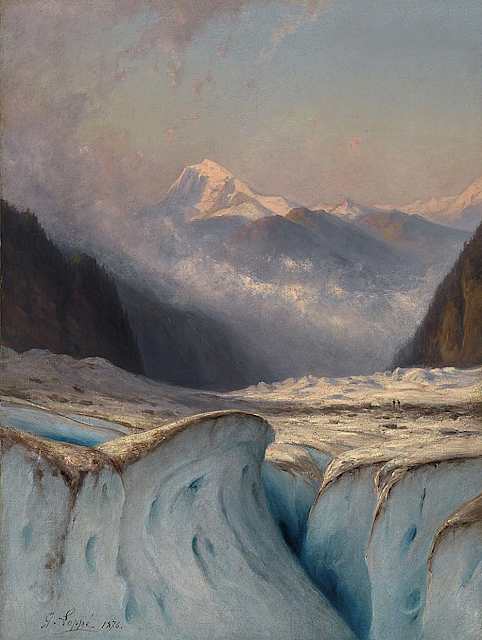GABRIEL LOPPÉ (1825-1913)
Mount Buet (3, 096 m - 10, 157 ft)
France
The mountain
Mount Buet (3, 096 m - 10, 157 ft) also called simply The Buet is a summit of the massif of Giffre, in Haute-Savoie. It is also called the Mont Blanc des Dames (The Ladies Mont Blanc). It dominates the Cirque des Fonds. From its summit, the highest in the department except the Mont-Blanc massif, offers an exceptional view of the latter, as well as the red needles and the Haut-Giffre. The Buet played an important role in the birth of mountaineering and the conquest of Mont Blanc in the 18th century.
The first a ascension took place in 1765 by Genevan scientist Jean André Deluc and his brother. The brothers Deluc reach first the summit of the Buet, on the side of Sixt in 1770. They conduct a series of experiments, including the calculation of the time required to bring water to a boil at this altitude. They are the first to use the barometer to measure an altitude. This epic is considered the first climb in the high mountains in the Alps. Six years later, in 1776, Horace-Bénédict de Saussure took the route and made preliminary observations to the ascent of Mont Blanc.
In 1910, the Grenairon refuge was built on Mount Buet. Destroyed in 1984 by a fire, it was rebuilt in 1985 in the same way.
The painter
Toussaint Gabriel Loppé was a French painter, photographer and mountaineer. He became the first foreigner to be made a member of the Alpine Club in London. His father was a captain in the French Engineers and Loppé's childhood was spent in many different towns in south-eastern France. Aged twenty-one Loppé climbed a small mountain in the Languedoc and found a group of painters sketching on the summit. He had found his calling and subsequently went off to Geneva where he met the reputed leading Swiss landscapist, Alexandre Calame (1810 -1864). Loppé took up mountaineering in Grindelwald in the 1850s and made friends easily with the many English climbers in France and Switzerland. Although he was frequently labelled as a pupil of Calame and his rival François Diday, Loppé was almost an entirely self-taught artist. He became the first painter to work at higher altitudes during climbing expeditions earning the right to be considered the founder of the peintres-alpinistes school, which became established in the Savoie at the turn of the nineteenth century.
Notable followers of Loppé include, Charles Henri Contencin (1875-1955) and Jacques Fourcy (1906-1990). Together with the first ascent of Mt Mallet in Chamonix’s Grandes Jorasses range, Loppé made over 40 ascents of Mont Blanc during his climbing career, which lasted until the late 1890s. He frequently made oil sketches from alpine summits, including a panorama of the view from the summit of Mont Blanc.
His paintings became celebrated for their atmosphere and spontaneity and he soon found himself taking part in many exhibitions in London and in Paris.
By 1896 Loppé had spent over fifty seasons climbing and painting in Chamonix. As the valley’s unrivalled ‘Court painter’ his work was in constant demand with the majority of his pictures going to English climbers and summer tourists.
In his later years, Loppé became fascinated with photography and was quite an innovator in this field too. His long exposure photograph of the Eiffel Tower struck by lightning, now in the Musée d'Orsay in Paris remains one of his iconic images.
_______________________________
2018 - Wandering Vertexes...
by Francis Rousseau
